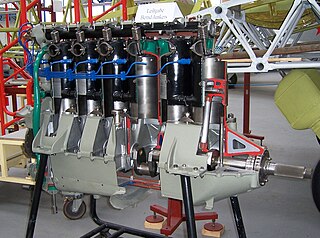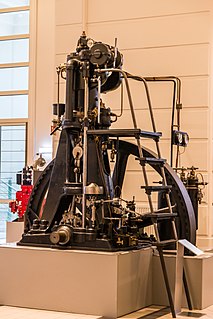
The Junkers Jumo 205 aircraft engine was the most famous of a series of aircraft Diesel engines that were the first, and for more than half a century the only successful aviation Diesel powerplants. The Jumo 204 first entered service in 1932. Later engines of this type comprised the experimental Jumo 206 and Jumo 208, with the Jumo 207 produced in some quantity for the Junkers Ju 86P and -R high-altiude reconnaissance aircraft, and the 46-meter wingspan, six-engined Blohm & Voss BV 222 Wiking flying boat. All three of these variants differed in stroke and bore and supercharging arrangements. In all more than 900 of these engines were produced, in the 1930s and through most of World War II.

The Rolls-Royce Condor aircraft piston engine was a larger version of the Rolls-Royce Eagle developing up to 675 horsepower (500 kW). The engine first ran in 1918 and a total of 327 engines were recorded as being built.

The Jabiru 5100 is a lightweight four-stroke horizontally opposed flat-eight air-cooled aircraft engine, manufactured by Jabiru Aircraft.

The Junkers L 5 was a six-cylinder, water-cooled, inline engine for aircraft built in Germany during the 1920s. First run in 1925, it was a much enlarged development of the Junkers L2, in turn a licensed development of the BMW IV.

The ULPower UL260i is a family of aircraft engines, produced by ULPower in Belgium.

The Napier Culverin was a licensed built version of the Junkers Jumo 204 six-cylinder vertically opposed liquid-cooled diesel aircraft engine built by D. Napier & Son. The name is derived from the French word, culverin, for an early cannon or musket. First flown in 1938, the engine went into limited production, with testing carried out on a Blackburn Iris V biplane flying-boat aircraft and Fairey IIIF biplane.
The D-Motor LF26 is a lightweight liquid cooled side-valve four-stroke flat four, 2.7 litre petrol aircraft engine, produced by D-Motor in Deerlijk, Belgium.
The Michel engine was an unusual form of opposed-piston engine. It was unique in that its cylinders, instead of being open-ended cylinders containing two pistons, were instead joined in a Y-shape and had three pistons working within them.
The Sauer S 2200 UL is a 4 stroke aircraft engine designed for homebuilt and ultralight aircraft.
The Rotax 915 iS is an Austrian aircraft engine, produced by Rotax of Gunskirchen for use in ultralight aircraft, homebuilt aircraft, light-sport aircraft, small helicopters and gyroplanes. The engine was type certified in 2017.
The AICTA LMD 416-00R is a Czech aircraft engine, that was designed and produced by AICTA Design Work of Prague for use in light aircraft.
The Diesel Air Dair 100 is a British diesel aircraft engine, designed and produced by Diesel Air of Olney, Buckinghamshire for use in airships and light aircraft.
The Parma Mikron III UL is a Czech aircraft engine, deveoped from the Walter Mikron and produced by Parma Technik sro of Luhačovice for use in ultralight aircraft.
The Superior Air Parts Gemini Diesel 100 is a diesel aircraft engine, under development by Superior Air Parts of Coppell, Texas, United States for use in homebuilt aircraft.
The Superior Air Parts Gemini Diesel 125 is a diesel aircraft engine, under development by Superior Air Parts of Coppell, Texas, United States for use in homebuilt aircraft.
The ULPower UL390i is a Belgian aircraft engine, designed and produced by ULPower Aero Engines of Geluveld for use in homebuilt aircraft.
The ULPower UL520i is a Belgian aircraft engine, designed and produced by ULPower Aero Engines of Geluveld for use in homebuilt aircraft.
The Vaxell 60i is a Polish aircraft engine, designed and produced by Vaxell of Bydgoszcz for use in ultralight and homebuilt aircraft.
The Vaxell 80i is a Polish aircraft engine, designed and produced by Vaxell of Bydgoszcz for use in ultralight and homebuilt aircraft.
The Vaxell 100i is a Polish aircraft engine, designed and produced by Vaxell of Bydgoszcz for use in ultralight and homebuilt aircraft.









